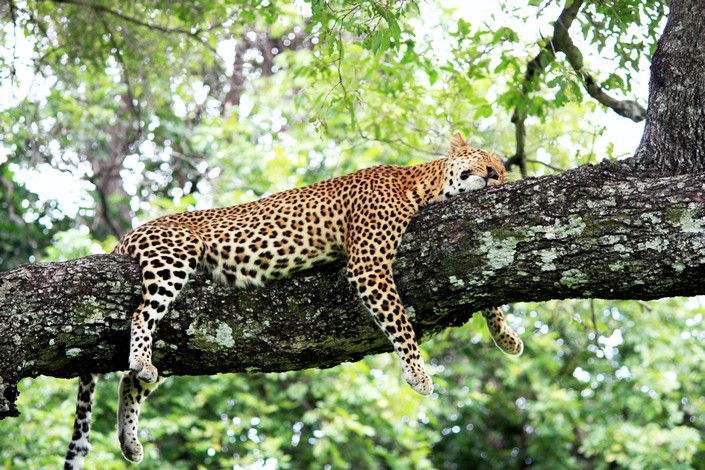Many places in Africa have distinct dry, wet, hot and cool periods during the year, which can affect travel plans hugely. You wouldn’t want to spend your two-week holiday on the tropical island of Zanzibar in the pouring rain, would you?
If you’re going on a wildlife safari in Africa, it’s important to choose the right month to travel in for the parks you’re going to visit – if you travel during the rainy season, you might see a lot of birds, but you won’t see a lot of game. In contrast, if you travel during the dry months, you’ll be treated to abundant wildlife sightings, as the dry foliage makes animals easier to spot, and the lack of water draws animals to water sources such as waterholes and rivers.
Here’s our guide on where to travel in Africa month by month:
January
The beginning of the year is a great time to visit the South African city of Cape Town, when the sunny, warm weather is perfect for beach hopping and wine touring.
Late January to February is when wildebeest calving happens in Tanzania’s Serengeti National Park, so if you want to see newborns (and predators on the prowl) this is when you should go.
February
If you’re into scuba diving, February is when you should visit Zanzibar – it’s one of the best times of year to dive, and the weather is hot and dry.
March
March to May are the best months to visit the Kgalagadi Transfrontier Park, which borders South Africa and Botswana. This is the end of the wet season, when the rivers attract animals, making them easy to spot.
April
The Namib Desert, in Namibia, is scorching during the summer months of November to March, so the best time to go is when it starts to cool down, from April onwards.
May
The best time of year to visit Kruger National Park (as well as most wildlife parks in southern Africa) is the winter months, from May to September. This is the driest time of year, which means the animals tend to congregate around waterholes. That, coupled with the fact that the vegetation is drier and sparser, makes the animals incredibly easy to find.
Namibia’s Etosha National Park is best visited in the winter months of May to October, when this arid region receives no rain. It’s super easy to spot lions, elephant, rhino and other animals at this time of year, because they all have to come to the waterholes to drink. Temperatures are also pleasant at this time of year – warm days and cool nights.
In Botswana, Chobe National Park’s dry season runs from May to October, when animals gather along the river to drink. September and October are extremely hot, making May, June, July and August the best months to visit.
June
June is the start of the dry season in Botswana’s Okavango Delta, when animals migrate to the Delta in search of water, making for excellent wildlife viewing. The temperature is also pleasant, and there also are less mosquitoes at this time of year.
June is the start of the dry season (which lasts until September) in Rwanda and Uganda, and is one of the best times of year to visit the central African countries if you’re thinking of going gorilla tracking. (While you can go gorilla tracking during the rainy season, the muddy paths make hiking more difficult.)
June marks the beginning of the dry season in Mozambique, and it’s the best time to visit the coastal country before it gets starts getting very hot in September.
The rainy season in Zanzibar ends in May, and June marks the beginning of the dry season, which lasts until October, and is the best time to visit the East African tropical island.
June is a great time to visit Tanzania’s flagship park, the Serengeti National Park, before the wildebeest return to the Masai Mara in Kenya around August. The rainfall at this time of year is low, while daytime temperatures average around 26 degrees centigrade.
July
July to October is the best time for the Ngorongoro Crater, when it’s dry season, animals are congregating around rivers and waterholes in search of water and there’s a low risk of malaria.
August
In August, the wildebeest herds move into Kenya’s Masai Mara, so if you want to see part of the famous Great Migration, head to the flagship East African park this month.
In late August, visit Namaqualand, in northwestern South Africa, for spectacular displays of wild spring flowers carpeting the arid semi-desert region.
September
September and October are good months to visit the Okavango Delta (as long as you don’t mind the heat), as the dry weather makes animals congregate at water sources, making them easy to spot.
October
October is a great time to hike in the Drakensberg in South Africa, when temperatures are pleasant and the mountains are green and lush.
November
In November the wildebeest herds make their way south to the Serengeti National Park in Tanzania.
This month it’s whale shark season in Zanzibar, so head to the tropical Tanzanian island if you’d like to dive with the biggest fish in the world (there’s also great visibility in the water in November).
Explore the beaches of Cape Town and South Africa’s Garden Route, as the weather warms up for the beginning of summer – before the Christmas holiday crowds arrive.
December
If you don’t mind the holidaymakers flocking to the beach, December is a great time to travel in South Africa, whether you go to Cape Town, the beaches of the Eastern Cape, or the beautiful KwaZulu-Natal coast.
In December, thousands of zebra arrive in the Kalahari Desert in Botswana for fresh grazing, as this arid land is transformed into a lush paradise with the summer rains.













0 Comments